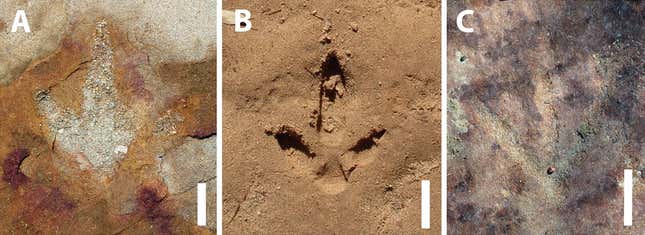Historic South People have been apparently impressed by fossilized dinosaur tracks in what’s now japanese Brazil, the place they lower figures into the rock, imprinted tens of hundreds of thousands of years earlier by the actions of giants.
The dinosaur tracks belong to theropods, sauropods, and iguanodontians, and are unfold throughout three rock outcroppings within the Brazilian state of Paraíba. The petroglyphs on the location consist primarily of round patterns, however a number of look very very similar to the tridactyl dinosaur tracks additionally current on the location. The crew’s analysis cataloguing the petroglyphs and related trackways was published in Scientific Experiences.
Neither the trackways nor the petroglyphs have been straight dated, however human burials relationship to 10,000 years in the past have been beforehand discovered at two close by websites. A type of websites, Pedra do Alexandre, has burials spanning from 9,400 years outdated to 2,620 years outdated, indicating there’s nonetheless a large time-frame wherein the petroglyphs might have been carved. However the petroglyphs placement, and the design of a few of the figures, was clearly impressed by the far more historic trackways.
Theropods have been a gaggle of bipedal, usually carnivorous creatures that features T. rex and all trendy birds. Sauropods have been large, herbivorous quadrupeds simply recognizable for his or her lengthy necks, if not their big our bodies. Iguanodontians have been a bipedal, herbivorous group that included the thumb-spiked, eponymous Iguanodon, in addition to the duck-billed hadrosaurs.

Brazil was as soon as a hotbed for a bevy of historic beasts, together with dinosaurs, their winged counterparts (pterosaurs), and other, more ancient reptiles. In actual fact, fossil smuggling out of Brazil stays a vexing drawback for authorities.
The proximity of the petroglyphs to the fossilized footprints reveals “lively engagement with the fossil materials,” the crew wrote, “suggesting that these traces not solely caught the eye of the native neighborhood however have been significant and have become built-in into their data repertoire.”
No petroglyphs overlapped with or brought about harm to the footprints on the location—“suggesting thoughtfulness by the makers,” they wrote. Absolute relationship of the petroglyphs utilizing X-ray fluorescence spectroscopy might reveal after they have been made—maybe throughout the centuries, by totally different teams.
The crew cites petroglyphs on the close by Junco archaeological website, which depict an assortment of geometric figures that resemble stars, spoked wheels, flowers, and (if you happen to squint) buildings. The petroglyphs have been authored by a number of folks, the crew concluded, primarily based on variation in fashion throughout the figures. Among the figures and trackways are severely broken because of flaking of the rock.

Given historic South People’ lack of recent understanding of dinosaurs, the crew added that the petroglyph makers could have mistaken the dinosaur trackways for rhea footprints. Rheas are trendy theropod dinosaurs and the most important hen in Brazil—certainly, native to the identical area the place the paleontological website sits.
That could be so, however not like the real rhea tracks these historic communities noticed, those within the rock in Paraíba didn’t go away. That gave the prints some significance to the local people, as evidenced by the traditional paintings positioned alongside them.
Trending Merchandise

Cooler Master MasterBox Q300L Micro-ATX Tower with Magnetic Design Dust Filter, Transparent Acrylic Side Panel…

ASUS TUF Gaming GT301 ZAKU II Edition ATX mid-Tower Compact case with Tempered Glass Side Panel, Honeycomb Front Panel…

ASUS TUF Gaming GT501 Mid-Tower Computer Case for up to EATX Motherboards with USB 3.0 Front Panel Cases GT501/GRY/WITH…

be quiet! Pure Base 500DX Black, Mid Tower ATX case, ARGB, 3 pre-installed Pure Wings 2, BGW37, tempered glass window

ASUS ROG Strix Helios GX601 White Edition RGB Mid-Tower Computer Case for ATX/EATX Motherboards with tempered glass…










